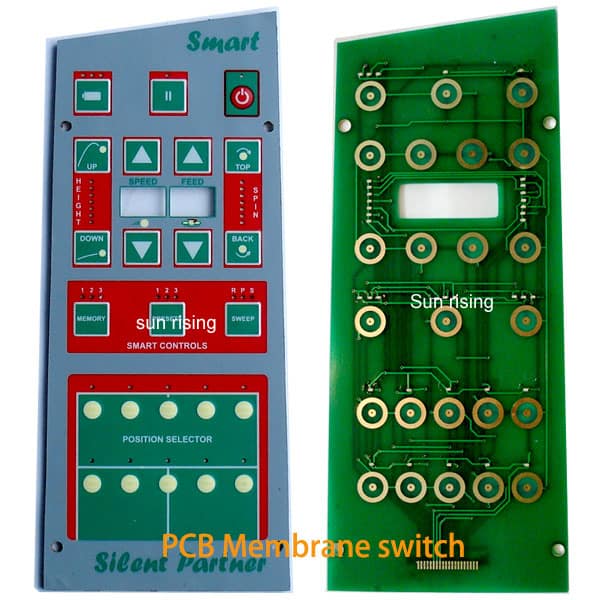The Role of Membrane Switches in Boosting Product Durability and Efficiency
The Role of Membrane Switches in Boosting Product Durability and Efficiency
Blog Article
Why Membrane Switches Over Are Vital for Sturdy Control Systems
Membrane switches play a pivotal role in ensuring the durability and reliability of control systems across numerous sectors. As we discover the diverse advantages of membrane buttons, it comes to be obvious that their relevance transcends mere capability, influencing individual experience and operational performance.
Summary of Membrane Buttons
Membrane buttons are flexible and dependable parts frequently utilized in numerous electronic control systems. These buttons include several layers, including a visuals overlay, a spacer layer, and a printed circuit layer. The visuals overlay supplies both functional and visual design, while the spacer layer makes certain that the buttons are turned on just when pushed. The printed circuit layer has conductive traces that complete an electric circuit when the membrane is pushed, enabling the tool to react to individual inputs.
Membrane layer switches are usually favored in applications needing a portable and lightweight style, making them excellent for handheld gadgets, clinical equipment, and industrial equipment. They can be tailored to meet specific individual needs and can incorporate different attributes such as backlighting, responsive feedback, and several shades. Membrane switches are resistant to dust, wetness, and pollutants, making them ideal for settings where durability is vital.
Advantages of Toughness
In several applications, the durability of membrane layer switches over deals considerable benefits that improve their general efficiency and dependability. These buttons are created to hold up against rough environments, making them ideal for use sought after conditions such as high humidity, extreme temperatures, and exposure to chemicals. Their robust building helps to avoid damage from physical impact, ensuring long-lasting functionality and minimizing the demand for constant substitutes.
Furthermore, membrane layer switches are resistant to deterioration, which is essential in applications where frequent communication takes place. This longevity converts to reduce maintenance costs, as companies profit from minimized downtime and fewer service disturbances. Moreover, the encapsulated style of membrane switches over shields interior components from dirt and wetness ingress, further adding to their life expectancy.
Another benefit is their capability to maintain constant efficiency with time. With a high tolerance for mechanical tension, these buttons preserve their responsive feedback and electric integrity, making certain individual satisfaction. Eventually, the resilience of membrane layer switches not only boosts operational efficiency however also promotes self-confidence in their dependability, making them a recommended choice for control systems throughout various markets.
Applications in Various Industries
Resilient control systems employing membrane layer switches discover considerable applications across a variety of industries, each benefiting from the one-of-a-kind characteristics these buttons offer. In the medical market, membrane switches are essential for gadgets such as person monitors and diagnostic tools, where reliability and simplicity of cleansing are extremely important. Their resistance to wetness and impurities ensures they keep functionality in sterile settings.
The automotive market leverages membrane layer buttons for control panel controls and infotainment systems, where they give sleek, inconspicuous interfaces that boost individual experience. These buttons are additionally designed to endure rough problems, consisting of exposure to extreme temperatures and vibrations.
In industrial settings, membrane switches are frequently made use of in equipment control board, check that supplying tactile feedback and sturdiness needed for high-usage applications. Their capacity to stand up to chemicals makes them ideal for making settings where spills and impurities are constant.

Customer electronic devices, such as kitchen area home appliances and push-button controls, additionally make use of membrane layer buttons for their adaptability and cost-effectiveness. Generally, the versatility and robust nature of membrane layer switches over make them vital throughout different industries, ensuring reliable procedure and longevity in control systems.
Design and Visual Charm
While performance is paramount, the layout and visual charm of control systems geared up with membrane buttons play a vital function in user involvement and general experience (membrane switch). The visual layout of these buttons can considerably influence individual assumption and interaction. A well-designed membrane switch enhances the appearance of the device, making it extra appealing to individuals and fostering a link between the user and the item
Membrane changes offer a large amount of flexibility in layout, allowing suppliers to personalize graphics, shades, and structures to align with brand name identity and item visual appeals. Using dynamic shades and distinctive patterns can attract focus, while tactile responses can reinforce the customer's interaction with the gadget. In addition, the capability to incorporate LED indicators and backlighting right into the membrane layer switch layout provides both practical and visual benefits, improving presence and usability in different settings.

Enhancing User Experience

Additionally, membrane layer buttons can be tailored to this article incorporate graphical user interfaces, improving usability by offering details in a clear and instinctive fashion (membrane switch). This customization can consist of icons, labels, and color coding that guide users with complicated performances with simplicity. Furthermore, their adaptability enables assimilation in numerous settings, making certain consistent efficiency whether in industrial equipment or customer electronic devices
The toughness of membrane switches additionally plays a critical duty in customer experience. By holding up against rough problems and prolonged usage, these buttons decrease the possibility of system failures, thus advertising integrity and customer confidence. Ultimately, the strategic usage of membrane layer changes not only boosts capability however additionally dramatically enriches customer communication with control systems, making them an important element in modern-day design.
Conclusion

Report this page